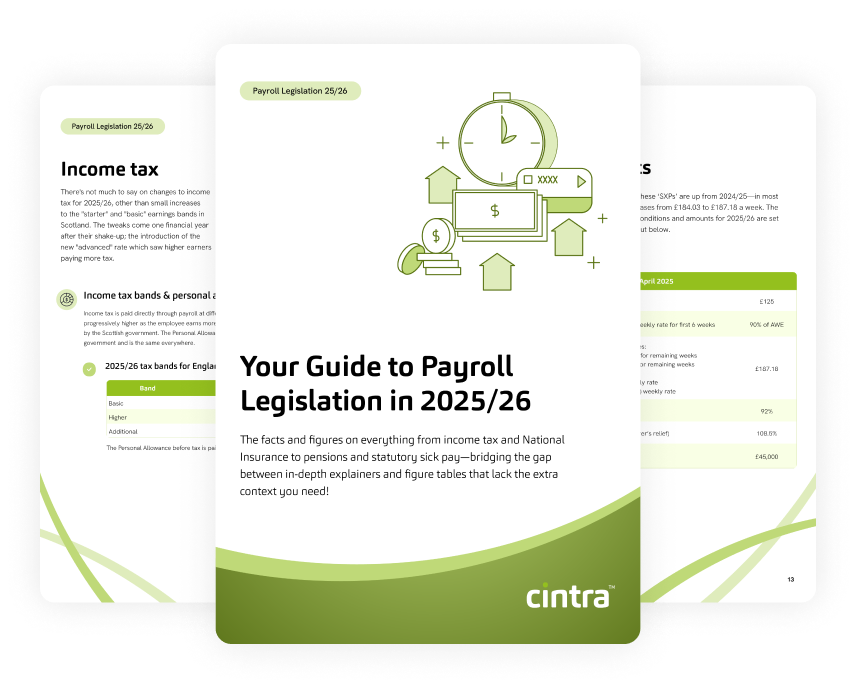Under the Pensions Act 2008, it’s your legal responsibility to offer a workplace pension scheme to eligible employees.
But how do you determine the amount you’ll need to contribute? It all comes down to the pensionable earnings of your employees.
There are three methods to calculate these earnings—basic pay, qualifying earnings, and total earnings. We’ll explain the differences between them and guide you on how to calculate each one.
What are pensionable earnings?
Pensionable earnings are the portions of an employee’s salary that count towards their pension contributions.
These typically consist of:
- Basic salary
- Commissions
- Overtime pay
However, pensionable earnings often do not include:
- Bonuses
Why are pensionable earnings important?
Pensionable earnings determine how much both you and your employees need to contribute to their workplace pension scheme. Accurate pensionable earnings are a win-win for both you and your employees:
For you
- Ensures compliance with auto-enrolment regulations, set by The Pensions Regulator (TPR) to avoid penalties.
- Accurately determines pension contributions for the tax year.
- Guarantees fair pension contributions for employees.
For your employees
- They will contribute the correct amounts to their pension, avoiding underpayments or overpayments.
- They have a clear understanding of their future pension entitlements.
- Ensures accurate tax relief on pension contributions, optimising take-home pay.
What are your obligations?
You are required to automatically enrol eligible employees in a workplace pension scheme. Here are the minimum contribution rates you need to be aware of:
- Employees: at least 5% of their pay
- Employers: at least 3% of the employee’s pay
These are the most common rates, but there are other contribution structures depending on the pay set used.
How to make sure you’re fulfilling your legal duties?
Whether you’re initiating automatic enrolment for the first time or seeking additional guidance, TPR can assist you. They will help make sure that your contributions meet the required minimum rates and that you fulfil your legal obligations.
Additionally, Cintra offers auto enrolment functionality and support as a standard feature with any payroll solution, ensuring that you have the tools needed to comply with your legal duties efficiently.
How to calculate pensionable earnings
Here, we’ll break down the three primary methods used for calculating pensionable earnings and provide clear examples for each.
Basic pay
Basic pay includes the core salary or wages an employee earns before any bonuses, overtime, or other additional payments are added.
It’s also worth noting that ‘basic pay’ is the most common and straightforward method of calculation.
Qualifying earnings
Qualifying earnings refer to earnings between a lower and upper threshold set by the government. This includes salary, wages, overtime, bonuses, statutory sick pay, statutory pay, holiday pay, and commission, but only the portion that falls within the defined thresholds.
- Lower threshold = £6,240 per year
- Upper threshold = £50,270 per year
For the complete earnings thresholds for the 2025/26 tax year, look further down the page.
Total earnings
Total earnings include all elements of an employee’s pay, such as salary, overtime, bonuses, commission, and any other earnings. The only income that doesn’t count is dividend income.
This is the most comprehensive calculation of the three methods.
Examples of pensionable earnings calculations
The following examples of pensionable earnings calculations reflect minimal contributions of 3% from the employer and 5% from the employee.
Basic pay
Let’s say one of your employees, let’s call her Jane has a basic pay of £32000.
This means you would contribute £960 (£32000 x 0.03), and Jane would contribute £1600 (£32000 x 0.05).
Qualifying earnings
Suppose Mike has an annual salary of £40,000 and £10,000 in commission.
Mike’s qualifying earnings would be: £43,760 (£50,000 – £6,240)
This means you would contribute £1,312.8 (£43,760 x 0.03) and Mike would contribute £2,188 (£43,760 x 0.05)
Total earnings
Imagine Emily has an annual salary of £28,000 with £6,000 in commission and £2,000 in bonuses.
Emily’s total earnings would be: £36,000 (£28,000 + £6,000 + £2,000)
This means you would contribute £1,080 (£36,000 x 0.03) and Emily would contribute £1,800 (£36,000 x 0.05)
Calculating pensionable earnings doesn’t have to be too complicated. Whether you opt for basic pay, qualifying earnings, or total earnings, it’s essential to choose the method that aligns best with your business’s payroll processes.
Get the latest insights and best practice guides, direct to your inbox.
What is automatic enrolment?
Automatic enrolment (also known as auto enrolment) is a vital initiative designed to ensure that your employees are saving for their retirement. You are required to automatically enrol eligible workers into a workplace pension scheme.
Who qualifies for automatic enrolment?
To qualify for automatic enrolment, you must meet three key criteria:
- First, you need to be between 22 years old and the State Pension age.
- Second, your annual earnings must exceed £10,000.
- Lastly, you must be employed within the UK.
Earnings thresholds for the 2025/26 tax year
Pay reference period | |||||||
2025/26 | Annual | 1 week | Fortnight | 4 weeks | 1 month | 1 quarter | Bi-annual |
Lower earnings limit (LEL) | £6,240 | £120 | £240 | £480 | £520 | £1,560 | £3,120 |
Earnings trigger for automatic enrolment | £10,000 | £192 | £384 | £768 | £833 | £2,499 | £4,998 |
Upper earnings limit (UEL) | £50,270 | £967 | £1,934 | £3,867 | £4,189 | £12,568 | £25,135 |
How to auto enrol your employees if they are above the threshold?
Via qualifying earnings
You’re still required to auto enrol employees even if their qualifying earnings are above the threshold. You’ll just discount any earnings over the £50,270 upper limit.
Via total earnings
Your employees’ pensionable earnings will not have an upper limit, aside from their annual pension allowance or lifetime allowance.
What if your employee’s earnings are below the threshold?
Employees under 22 won’t be auto enrolled in the pension scheme, but if they earn £6,240 or more, they can choose to opt in and receive the minimum employer contributions.
Ready to simplify pensionable earnings?
Managing pensions shouldn’t be a hassle. With Cintra, you can easily handle multiple pension types, streamline auto enrolment, and automate deductions—all in one platform. Whether your payroll is in-house or outsourced, we’ve got you covered. Book a demo today and see how Cintra makes pension management effortless.

Payroll Legislation Guide
The facts, figures, thresholds and allowances for 2025/26 spanning tax, National Insurance, pensions, statutory payments and more.
Download now


